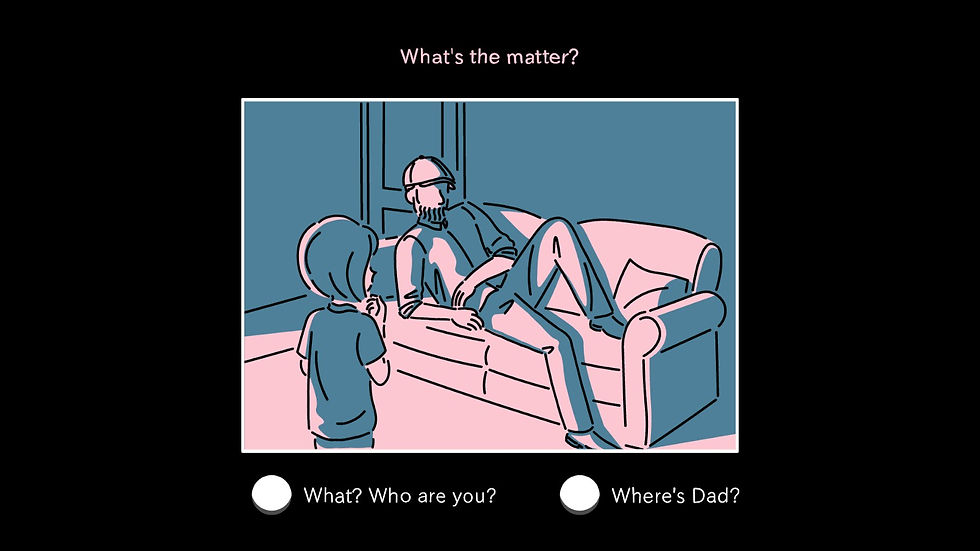And Roger Review: An Emotional Ride | The Gamerheads Podcast
- Roger Reichardt

- Jul 30
- 4 min read
Updated: Dec 7

Platform reviewed: Steam (PC)
Also on: Nintendo Switch
Price: $4.99
Writing a review for And Roger is surprisingly tough—not because it’s a bad game (it’s fantastic) but because so much of its impact comes from playing the game. I fear that almost anything I say risks spoiling the experience. I’ll do my best not to ruin the game. But trust me, it’s worth a playthrough.
And Roger feels less like a game and more like an experience. It has gameplay elements, sure, but from the moment I started, I knew I was in for a ride. At its core, it’s an interactive visual novel. But how it pulled me into the story, through the narrative and interactions, is something very different than any other visual novels I’ve played.
At the time, I didn’t understand why something as basic as typing my name felt so difficult—but later in the game, I became aware of the experience TearyHand Studio was crafting.
The game opens with a simple prompt: click a button. In fact, almost every interaction in And Roger comes down to moving or clicking a button—but what seems simple becomes challenging. Even routine actions become difficult. Case in point: entering my name. The moment I began typing, the screen glitched. Thinking I’d made a mistake, I hit backspace, only to find the same distortion. Eventually, I realized I just needed to keep clicking the button. At the time, I didn’t understand why something as basic as typing my name felt so difficult—but later in the game, I became aware of the experience TearyHand Studio was crafting.

The next scene puts me in control of a little girl waking up in the morning. At first, everything feels normal—until the music shifts, subtly hinting that something is off. I walk into the living room to find a stranger sitting there, and the girl immediately becomes anxious, asking who this person is and where her dad has gone. The man doesn’t seem overtly menacing, but the music and her reactions make the moment feel tense.
These moments showcase one of And Roger’s strengths: using color and minimalist visuals to convey emotion (and call back moments) in powerful ways.
He tells me to sit and eat breakfast, introducing another “simple” button-learning challenge. At first, I fumble through it, figuring out which buttons control the spoon, scoop the food, and bring it to my mouth—only for decoy buttons to appear, making the task frustratingly harder. The game does this a lot - introducing a trial and error mechanic to figure out what exactly I need to do, then add decoy buttons making the task more complex. At first, I chalk up the additional buttons, and the frustration that sets in, to my character feeling stressed. To be frank, I was stressed too. Who is this man feeding me? Why is he here? And who am I?

After a failed attempt to call 911—foiled by the man—my character makes a break for it. This section introduces some clever mechanics: I have to press a button at just the right moment to duck whenever the man looks my way, slowly filling an escape progress bar. I also click a button to move a set of footprints across the room, carefully guiding each step to avoid any light streaming in. These moments showcase one of And Roger’s strengths: using color and minimalist visuals to convey emotion (and call back moments) in powerful ways.

The first chapter is intense and by the end of it, I found myself asking: what the hell is going on?
For me, there was one distinct moment when it all clicked—when I finally understood why everyday tasks felt frustrating, why I didn’t know who that strange man was, and why I didn’t even learn my character’s name until the third chapter.
It’s hard to go deeper into the story without giving too much away, but what I can say is this: the game unfolds through key moments in the woman’s life, each carrying its own emotional weight. There are moments when things feel happy and the music shifts to bright melodies and warm colors; then there are tense moments, and the soundtrack dips into minor keys and the visuals darken, amplifying her frustration and pain. And these moments blend together seemlessly. It’s a brilliant design choice that lets me feel what the protagonist feels and what she's going through.
For me, there was one distinct moment when it all clicked—when I finally understood why everyday tasks felt frustrating, why I didn’t know who that strange man was, and why I didn’t even learn my character’s name until the third chapter. That moment will likely be different for everyone, but it’s what makes And Roger so powerful.
Final Grade: A+
Be prepared for an emotional rollercoaster with And Roger. This game made me feel everything the protagonist felt—fear, frustration, sadness, even moments of joy. It only takes about an hour to finish, but like any great piece of art, I found myself processing and reflecting on it well after I completed the game.
Review code provided by Stride PR







Comments